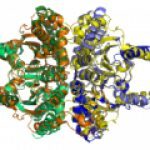Link to Pubmed [PMID] – 10486977
Mol. Biol. Evol. 1999 Sep;16(9):1219-30
Prokaryotic genomes seem to be optimized toward compactness and have therefore been thought to lack long redundant DNA sequences. However, we identified a large number of long strict repeats in eight prokaryotic complete genomes and found that their density is negatively correlated with genome size. A detailed analysis of the long repeats present in the genome of Bacillus subtilis revealed a very strict constraint on the spatial distribution of repeats in this genome. We interpret this as the hallmark of selection processes leading to the addition of new genetic information. Such addition is independent of insertion sequences and relies on the nonspecific DNA uptake by the competent cell and its subsequent integration in the chromosome in a circular form through a Campbell-like mechanism. Similar patterns are found in other competent genomes of Gram-negative bacteria and Archaea, suggesting a similar evolutionary mechanism. The correlation of the spatial distribution of repeats and the absence of insertion sequences in a genome may indicate, in the framework of our model, that mechanisms aiming at their avoidance/elimination have been developed.


